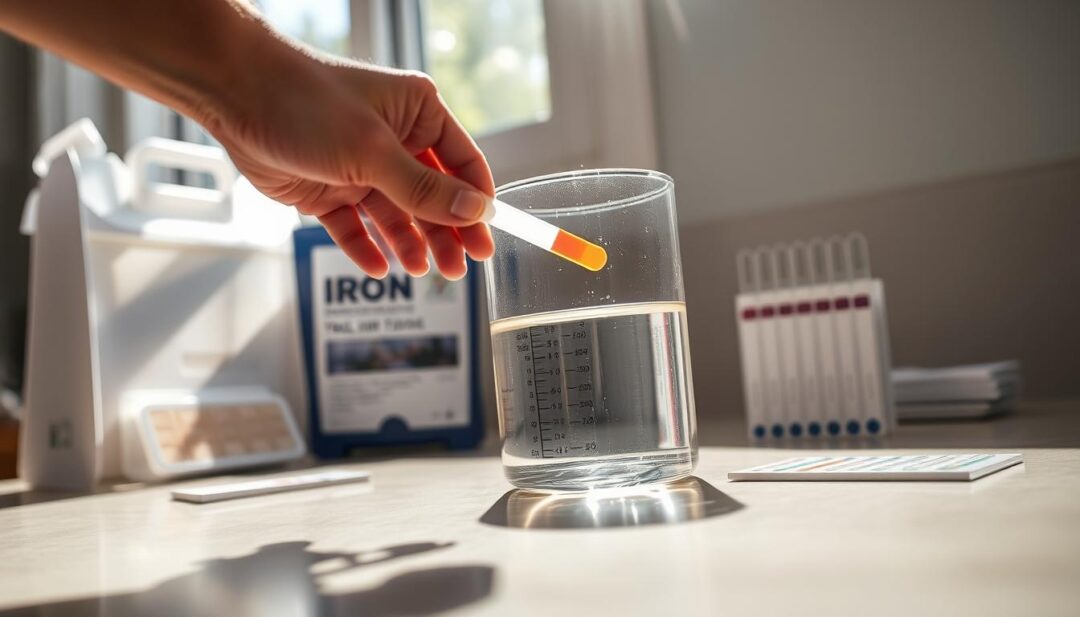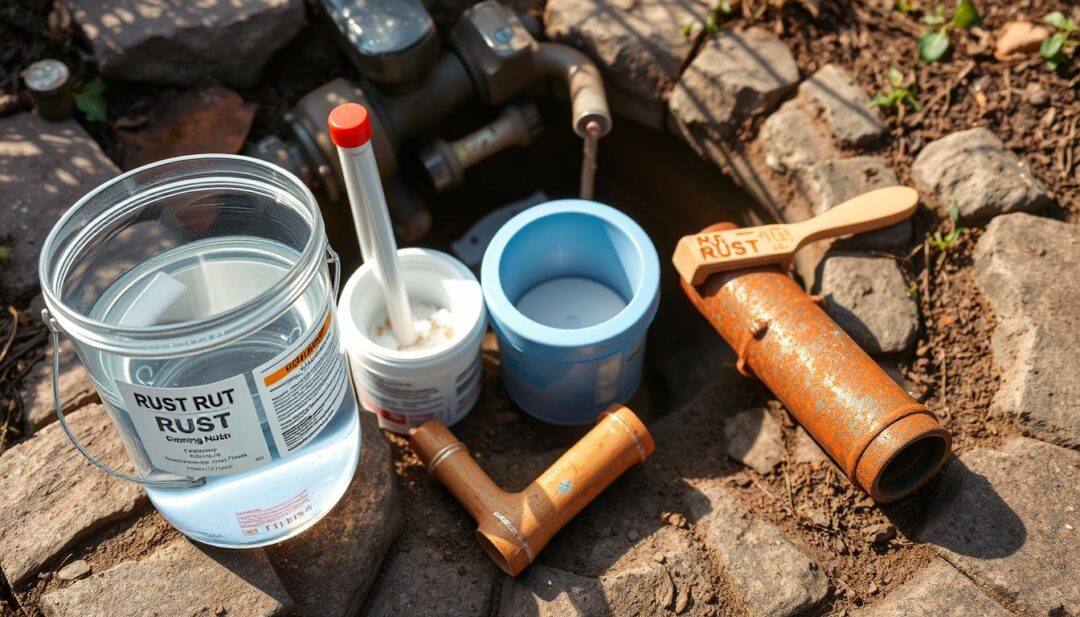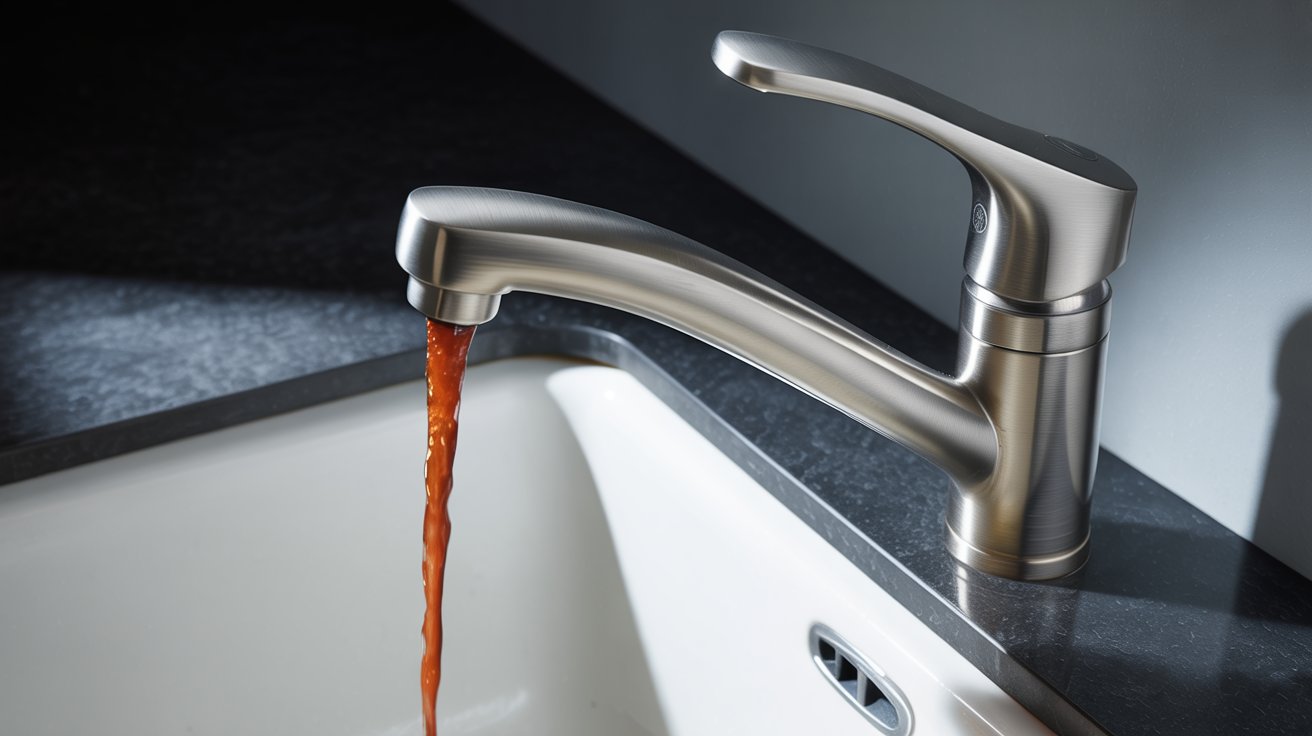Rust in Well Water: Causes, Risks, and Solutions
Did you know that nearly 15% of Americans rely on private wells for their drinking water, and a significant portion of these wells are at risk of contamination due to high levels of iron, leading to rust discoloration?
This issue is not just about aesthetics; rust in well water can indicate underlying problems that pose health risks and damage household appliances. The presence of iron is a common cause, as it reacts with oxygen to form rust.
Understanding the causes, risks, and potential solutions is crucial for homeowners relying on well water. This article will explore these aspects in detail, providing insights into how to mitigate the issue.
Key Takeaways
- High iron levels can cause rust discoloration in well water.
- Rust in well water may signal underlying health and appliance risks.
- Understanding the causes is key to finding effective solutions.
- Homeowners can take steps to mitigate rust-related issues.
- Regular maintenance and testing are crucial for well water quality.
What Causes Rust in Well Water
Understanding the causes of rust in well water is crucial for homeowners relying on well water systems. Rust in well water is primarily caused by the presence of iron, which upon oxidation, forms the reddish-brown substance we commonly refer to as rust.
The Science Behind Iron Oxidation
Iron oxidation occurs when iron-rich water comes into contact with oxygen. This reaction is accelerated in acidic environments or when the water is exposed to air. The oxidation process converts soluble ferrous iron into insoluble ferric iron, which precipitates out as rust. This process is not only a cosmetic issue but can also affect the taste, odor, and overall quality of the water.
Natural vs. Plumbing-Related Sources
The sources of iron in well water can be categorized into natural and plumbing-related sources. Naturally, iron is present in the earth’s crust, and groundwater can pick up iron as it passes through iron-rich soil and rock formations. On the other hand, plumbing-related sources include corroded pipes and fixtures within the household plumbing system. Distinguishing between these sources is crucial for implementing the correct treatment solution.
Regional Factors in the United States
Regional geology plays a significant role in determining the iron content in well water. Areas with high iron deposits in the soil and rock are more likely to have higher levels of iron in their groundwater. For instance, regions with significant iron ore deposits or certain types of sedimentary rocks may have higher iron concentrations in well water. As noted by water quality experts, “The geology of an area is a key determinant of the water quality, including its iron content.”
“The quality of well water can vary significantly from one region to another, depending on local geology and other environmental factors.”
In conclusion, the causes of rust in well water are multifaceted, involving both natural and man-made factors. Understanding these causes is the first step towards mitigating the issue and ensuring access to clean, clear water.
Identifying High Iron in Well Water
High iron in well water can be identified through several key indicators that homeowners should be aware of. Recognizing these signs early can help in addressing the issue before it becomes a more significant problem.
Visual Indicators of Iron Contamination
One of the most noticeable signs of high iron in well water is its appearance. Water with elevated iron levels often appears cloudy, murky, or discolored, ranging from yellow to reddish-brown hues. This discoloration is due to the oxidation of iron when it comes into contact with air.
Taste and Odor Changes
Iron contamination can also affect the taste and odor of well water. Water with high iron content may have a metallic taste or an unpleasant odor, often compared to rotten eggs or sewage. These changes are not only unappealing but can also indicate the presence of other contaminants.
Rust Stains in Well Water Systems
Another indicator of high iron in well water is the presence of rust stains. These stains can appear on fixtures, appliances, and laundry, signaling that the water contains excessive iron. Rust stains are not just aesthetically displeasing; they can also indicate potential damage to plumbing and appliances over time.
By being aware of these indicators, homeowners can take proactive steps to address high iron levels in their well water. Regular monitoring and appropriate treatment can help maintain water quality.
Health and Household Impacts of Rusty Water
Beyond the visual and taste issues, rusty well water poses various health and household risks. The presence of iron and other metals can lead to a range of problems that affect both the well water users’ health and the overall maintenance of their homes.
Is Drinking Rusty Water Dangerous?
Drinking rusty water is generally not considered dangerous in the short term, but long-term consumption can lead to health issues. The primary concern is not the iron itself but the potential for other contaminants to be present alongside it. Regular testing of well water is crucial to ensure it’s safe for consumption.
Damage to Appliances and Plumbing Fixtures
Rusty water can cause significant damage to household appliances and plumbing fixtures. Iron deposits can clog pipes, reduce water pressure, and stain fixtures. Water treatment systems can mitigate these issues by removing excess iron.
| Appliance/Fixture | Potential Damage | Mitigation Measure |
|---|---|---|
| Washing Machines | Clogging, Staining | Iron removal filters |
| Water Heaters | Reduced Efficiency, Failure | Regular Maintenance |
| Plumbing Fixtures | Staining, Corrosion | Iron-resistant materials |
Effects on Laundry and Dishwashing
Rusty water can stain laundry and dishes, making them appear dirty even after washing. Using water softeners or iron removal systems can help alleviate these issues.
Long-term Property Value Considerations
The presence of rusty water can impact property values. Addressing the issue promptly can help maintain or even increase property value over time.
How to Test for Rust in Well Water
Testing for rust in well water is a crucial step in ensuring the quality and safety of your water supply. Rust, or iron oxide, can enter your well water through various means, including natural sources and corroded plumbing.
DIY Testing Kits and Methods
For homeowners who prefer a hands-on approach, DIY testing kits are available. These kits usually include test strips or a colorimetric test that changes color based on the iron concentration in the water. While convenient, DIY kits may not provide the precision of professional testing.
Professional Water Analysis Services
For a more accurate assessment, consider hiring professional water analysis services. These experts use sophisticated equipment to measure iron levels and identify other potential contaminants in your well water. Their comprehensive reports can guide you in selecting the appropriate treatment solutions.
Interpreting Iron Level Results
Once you’ve conducted a test, understanding the results is crucial. Iron levels are typically measured in milligrams per liter (mg/L) or parts per million (ppm).
Safe vs. Problematic Iron Concentrations
Iron concentrations below 0.3 mg/L are generally considered safe, though aesthetic issues like taste and odor may still occur. Levels above 0.3 mg/L can cause noticeable staining and other problems.
When to Take Action
If your test reveals iron levels above 0.3 mg/L, it’s time to consider treatment options. Installing an iron water filter system for home can effectively reduce iron concentrations, improving water quality and reducing the risk of damage to appliances and plumbing.

Iron Bacteria in Well Water
Iron bacteria in well water can lead to a myriad of issues, affecting both the quality and safety of the water supply. These bacteria are naturally occurring microorganisms that can be found in soil, rocks, and water environments.
Recognizing Bacterial Iron Contamination
Bacterial iron contamination can be identified through several indicators, including unpleasant odors, slimy textures, and visible signs of biofilm formation in well water systems. Homeowners may notice that their water has a distinctive sewage or metallic smell, which can be a sign of iron bacteria presence.
How Iron Bacteria Differ from Regular Rust
Unlike regular rust, which is primarily an oxidation issue, iron bacteria are living organisms that thrive in environments with iron and oxygen. They can cause the formation of biofilms, which are complex communities of microorganisms that adhere to surfaces, potentially clogging pipes and reducing water flow.
Health Implications of Iron Bacteria
While iron bacteria themselves are generally not harmful, they can contribute to the presence of other harmful bacteria and contaminants in well water. According to a study by the Minnesota Department of Health, iron bacteria can also cause aesthetic issues, such as unpleasant tastes and odors, making the water unpalatable.
Biofilm Formation and Well Degradation
Iron bacteria can lead to the formation of biofilms, which not only clog pipes but also contribute to the degradation of well infrastructure. This can result in increased maintenance costs and potentially lead to more severe issues if left unaddressed. For more information on addressing related issues, such as sewage smells in well water, visit this resource.
Effective Well Water Rust Removal Methods
Effective well water rust removal requires a multi-faceted strategy that includes various treatment technologies. The choice of method depends on the level of iron contamination, the presence of other contaminants, and the specific needs of the household or facility.
Water Softeners: Capabilities and Limitations
Water softeners are commonly used to treat hard water but can also be effective in removing some iron. They work by exchanging sodium or potassium ions for calcium and magnesium ions, which are the primary causes of water hardness. However, their effectiveness for iron removal is limited to low concentrations of iron, typically less than 5 mg/L. For higher iron levels, additional treatment methods are necessary.
Oxidation Filtration Systems
Oxidation filtration systems are highly effective for removing iron from well water. These systems work by oxidizing the iron, making it easier to filter out.
Air Injection Oxidizers
Air injection oxidizers introduce air into the water, which reacts with the iron to form iron oxide (rust), a solid that can be filtered out. This method is efficient and can handle higher iron concentrations.
Chemical Oxidation Methods
Chemical oxidation involves adding chemicals like chlorine or potassium permanganate to oxidize the iron. While effective, these methods require careful handling and dosing to avoid over-oxidation or other adverse effects.

Sediment Filters for Rust Particles
After oxidation, sediment filters can effectively remove the resulting iron oxide particles. These filters come in various micron ratings and can be used alone or in combination with other treatment methods.
Reverse Osmosis Solutions
Reverse osmosis (RO) is a comprehensive water treatment method that can remove a wide range of contaminants, including dissolved iron. While effective, RO systems can be more expensive and may require additional pre-treatment steps to ensure optimal performance.
In conclusion, the most effective well water rust removal method often involves a combination of technologies tailored to the specific water quality issues at hand. By understanding the capabilities and limitations of each treatment option, homeowners can make informed decisions to ensure clean, clear, and safe well water.
Installing a Rust Filter for Well Water
The presence of rust in well water necessitates the installation of a reliable filtration system to safeguard health and household appliances. Rust filters are designed to remove iron and other contaminants, improving the overall quality of well water. When considering the installation of a rust filter, several factors come into play to ensure the chosen system meets the specific needs of the household.
Choosing the Right System for Your Needs
Selecting the appropriate rust filter involves assessing the level of iron contamination, the volume of water needed, and the type of iron present (ferrous or ferric). Water testing is crucial in determining the right filtration system. Different systems are designed to handle different types and levels of contamination.
Whole-House vs. Point-of-Use Solutions
Homeowners must decide between whole-house filtration systems, which treat all the water in the home, and point-of-use systems, which filter water at a single tap. Whole-house systems provide comprehensive protection, while point-of-use systems are more targeted and can be more cost-effective.
DIY Installation Guidelines
For those inclined towards DIY projects, installing a rust filter can be a manageable task. It’s essential to follow the manufacturer’s instructions and ensure that the system is compatible with the existing plumbing. Key steps include shutting off the main water supply, correctly sizing the filter, and properly disposing of the backwash.
Professional Installation Considerations
Hiring a professional can ensure that the installation is done correctly and efficiently. Professionals can assess the plumbing system, recommend the most suitable filter, and handle any complex installation issues.
Maintenance Requirements and Costs
Regular maintenance is vital for the longevity and effectiveness of a rust filter. This includes replacing filter cartridges, cleaning the system, and checking for any signs of wear or malfunction. The cost of maintenance can vary depending on the system and the frequency of replacement parts.
Preventing Future Rust Problems in Well Systems
Preventing rust in well water requires a proactive approach to well maintenance. By implementing regular maintenance practices and staying informed about the condition of your well, you can significantly reduce the risk of rust contamination.
Regular Well Maintenance Practices
Regular maintenance is the cornerstone of preventing rust in well water. This includes annual inspections of the well casing, cap, and surrounding area to ensure there are no signs of damage or deterioration. Additionally, it’s crucial to check the well’s electrical and mechanical components regularly.
Another key aspect is to keep the area around the well clean and free from potential contaminants. This involves proper disposal of waste and chemicals, and ensuring that the well is not located near potential sources of pollution.
Well Construction and Rehabilitation Options
The construction of your well plays a significant role in preventing rust. Proper well construction involves using materials that are resistant to corrosion and ensuring that the well is deep enough to access water that is less likely to contain high levels of iron.
In some cases, rehabilitation of the well may be necessary. This can involve cleaning or replacing the well screen, or redeveloping the well to improve its flow and reduce the likelihood of iron contamination.
Water Treatment System Upkeep
If you have a water treatment system in place, regular upkeep is essential. This includes filter replacements and cleaning of the system to ensure it continues to function effectively.
Monitoring Water Quality Changes
Ongoing monitoring of your water quality is crucial for early detection of potential issues. Regular water testing can help identify changes in iron levels or other water quality parameters, allowing you to take corrective action before rust becomes a significant problem.
By following these guidelines and staying proactive, you can help prevent rust problems in your well system and ensure a clean, safe water supply.
Conclusion: Managing Rust for Clean, Clear Well Water
Managing rust in well water is crucial for ensuring a safe and reliable water supply. Throughout this article, we’ve explored the causes of rust in well water, its impacts on health and household systems, and effective methods for removal and prevention.
By understanding the sources of iron contamination and implementing appropriate treatment solutions, homeowners can enjoy clean well water and clear well water. Regular testing and maintenance are key to preventing future rust problems and protecting your well system’s integrity.
Whether you’ve chosen to install a rust filter or implement other treatment methods, staying proactive is essential. By doing so, you’ll not only improve the quality of your well water but also safeguard your family’s health and the longevity of your plumbing and appliances. Effective managing rust in well water requires ongoing effort, but the benefits of having clean and clear well water make it well worth the investment.
Frequently Asked Questions
What causes rust in well water?
Rust in well water is primarily caused by the presence of iron. When iron is exposed to air, it oxidizes and forms rust. This iron can come from natural sources such as soil and rocks, or from corroded plumbing and pipes.
How can I identify if my well water contains high levels of iron?
High levels of iron in well water can be identified by reddish-brown discoloration, changes in taste and odor, and rust stains on fixtures and laundry. For accurate results, it’s best to test your water.
Is drinking rusty water dangerous?
While generally not a major health risk, drinking rusty water can cause gastrointestinal discomfort for some people. It may also indicate issues like iron bacteria or corroded pipes, which could have broader health implications.
How do I test for rust in my well water?
Rust in well water can be tested using DIY kits or by hiring a professional water analysis service. These methods measure the iron concentration to assess safety levels.
What are the effective methods for removing rust from well water?
Effective rust removal methods include:
- Water softeners
- Oxidation filtration systems (e.g., air injection or chemical oxidation)
- Sediment filters
- Reverse osmosis units
The ideal solution depends on your water’s iron concentration and other factors.
Can iron bacteria in well water cause health problems?
Iron bacteria aren’t typically harmful on their own, but they can promote biofilm growth that harbors other bacteria. They also cause unpleasant tastes, odors, and staining.
How often should I maintain my well water treatment system?
Maintenance frequency varies by system type and usage. Always follow the manufacturer’s recommendations and conduct regular checks to ensure optimal performance.
Can I install a rust filter for my well water myself?
Yes, if you have the right tools and follow the manufacturer’s instructions. For more complex systems or if you’re uncertain, professional installation is advisable.
How can I prevent future rust problems in my well system?
To prevent rust issues:
- Perform regular well maintenance
- Ensure proper well construction
- Maintain your water treatment system
- Monitor water quality consistently
What is the difference between whole-house and point-of-use rust filtration systems?
- Whole-house systems: Treat all water entering your home, offering full protection.
- Point-of-use systems: Treat water at specific outlets, such as a kitchen faucet, for targeted use.







